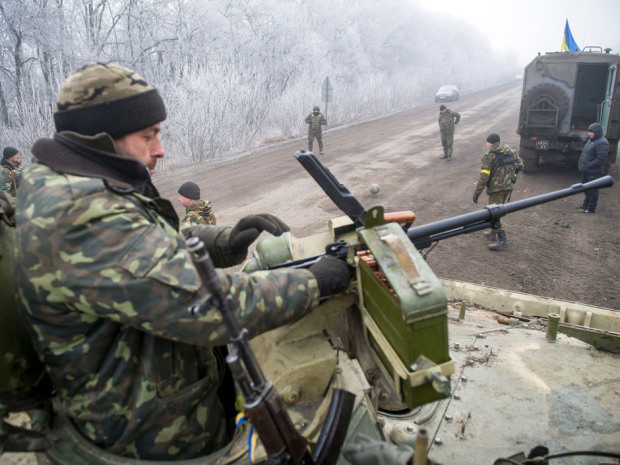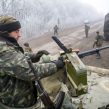
Russia’s Role in the Fall of Debaltseve
Publication: Eurasia Daily Monitor Volume: 12 Issue: 34
By:

In the aftermath of concluding the Minsk Two agreements earlier this month, the strategically important Debaltseve soon fell to the Russia-backed Ukrainian separatists—amidst clear disagreement over whether or not the latest ceasefire applied to the town. During the sixteen-hour talks in Minsk, on February 12, Russian President Vladimir Putin reportedly tried to hold out for a ten-day delay in the initiation of the ceasefire in order to resolve the situation around Debaltseve. As the “Normandy Four” continued their talks, allegations were made from the North Atlantic Treaty Organization (NATO) and other sources that more military hardware and manpower was crossing into Ukraine from Russian territory. Within a few days, Debaltseve finally fell into rebel hands, marking another humiliating setback for President Petro Poroshenko and the Ukrainian government’s beleaguered Anti-Terrorist Operation (ATO). Yet, there are signs in the background that far from marking a rebel victory, or being another indication of the alleged use of “hybrid warfare,” in fact, Debaltseve fell to a Russian combined-arms operation (Vedomosti, February 19).
The search for evidence of direct Russian military participation in the operation, scarce as it is due to continued “plausible deniability” by Moscow, resembles an analysis of shadows on a wall. Nonetheless, the emergence of numerous shadows appears to support the involvement of Russian regular troops. Apart from increased reports of military hardware and manpower crossing into Ukraine from Russia, even during the talks in Minsk, there are two clear shadows that were cast over the Russian manufactured narrative: the presence in the town of a senior Russian general, which Moscow has struggled to explain, and sightings of military hardware belonging to a Russian brigade from the North Caucasus.
The identification of a senior Russian general in Debaltseve, on February 17, prompted elements of the Russian media into near-contortions in an effort to explain or dismiss the sighting of his presence there. Lieutenant-General Aleksandr Lentsov, former deputy commander of the Airborne Forces (VDV) and now serving as deputy commander of the Russian Ground Forces, had slipped from public view in late 2014. Russian media reported, on February 19, that a man “resembling” Lentsov had appeared in Debaltseve. Novaya Gazeta journalists had spotted General Lentsov in video footage taken in the town on February 17. “We have identified the man with the face of a Hemingway-style old man, who is standing near Kiselyov, a DPR [self-proclaimed Donetsk People’s Republic] representative. He says: ‘We have been shot at. We have been betrayed.’ In this text, he absolutely identifies himself with the DPR side. To us, he looks like Lentsov,” Novaya Gazeta editor-in-chief, Dmitry Muratov, told Ekho Moskvy. He added that his colleagues asked the DPR to establish “who is the man that DPR representative Kiselyov looks back at as if he was some senior?” Muratov later said that the DPR replied saying they could not identify the man in the video, but referred to him by a nom-de-guerre, “Yustas” (Ekho Moskvy, February 19; Novaya Gazeta, February 17). “Yustas” is the nickname of fictional Soviet spy Schtirlitz (in a novel by Yu. Semenov).
However, amidst the confusion that erupted over the sighting of the “man who looks like” a senior Russian general, on February 18, state TV channel Rossiya 1 aired General Lentsov denying his involvement in military operations in Debaltseve. “The information that emerged in the media today, I not only deny it, it is a blatant lie. Because [of] the work that was done today, we arrived in Mayorsk, from Mayorsk to Horlivka, from Horlivka to Donetsk. […] I departed from here about an hour ago. But I was told while traveling that I should definitely speak in public and deny that I am or even was in Debaltseve. I could not physically arrive there today,” the man captioned as the “head of a group from the Russian side on coordination of issues related to the ceasefire, Lieutenant-General of the Russian Armed Forces Aleksandr Lentsov” was shown saying. Rossiya 1 noted that an official Russian mission was monitoring the ceasefire in southeastern Ukraine (Ekho Moskvy, February 19; Rossiya 1 TV, February 18).
Also on February 19, Interfax reported that General Lentsov had telephoned Rossiya 1 with more details of his denials of involvement in the conflict, protesting that his role there was linked only to the ceasefire agreement. Lentsov said: “At the joint center, we have worked together with our Ukrainian colleagues on coordinating a sector-by-sector plan for the opposing sides to withdraw heavy weapons to a safe distance. I can confirm the sides’ mutual interest in an organized withdrawal, as quickly as possible, of artillery systems from the line of contact in accordance with the Minsk Agreements of September 19 [2014] and the agreements of February 12 [2015]” (Interfax, February 19).
In addition to the presence of a senior Russian general appearing in a combat zone in southeastern Ukraine, the question of military hardware supplied by Russia also resurfaced. Not only were there sightings of Russian T-72B3 tanks, which served to confirm the supply of Russian hardware and also implied the use of Russian military personnel, but other reports seemed to offer evidence of at least elements from the Russian Ground Forces crossing the Ukrainian border. One such example appeared in video footage published by LifeNews, showing Russian military hardware in Debaltseve with markings clearly identifying a tank as belonging to the 136th Motorized Rifle Brigade, normally stationed in Buynask, Dagestan (LifeNews, February 15). These traces of equipment, material support for the attack on Debaltseve, and continued reports of the involvement of regular Russian troops point to a combined-arms operation to take the town. And given Putin’s hesitance over the timing of the latest ceasefire, this combined-arms operation appears to have moved ahead of schedule.
Russian journalist Andrey Kolesnikov said that the Debaltseve issue was the main area of contention during the Minsk talks. According to Kolesnikov, Putin said that the Ukrainian military units at Debalsteve were surrounded, which could have undermined the ceasefire agreement; all sides disputed whether the ceasefire actually applied to the town. Other Russian analysts noted the importance of Debaltseve and suggested that both the (Moscow-backed) rebels and the Ukrainian military needed a respite from the fighting. Vladimir Yevseyev, the director of the Moscow-based Center of Social and Political Sciences, said that after the Ukrainian army pull-out from Debaltseve it will need several months to recover its combat capabilities (The Moscow Times, February 18; Kommersant, February 13).




